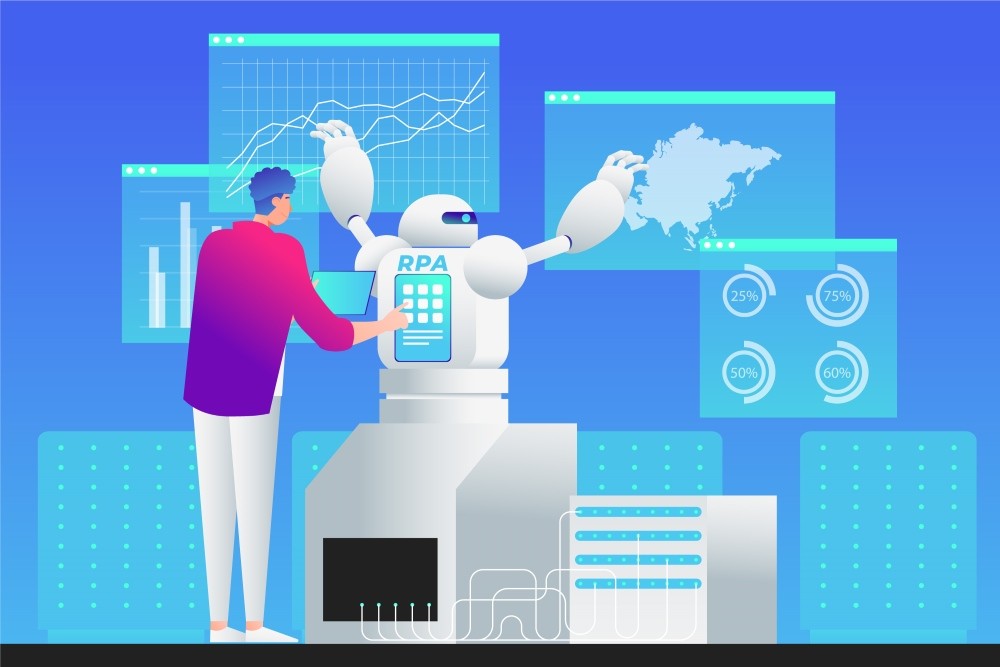Source: Freepik
In the rapidly evolving financial landscape, Artificial Intelligence (AI) in banking is not just an emerging trend but a transformative force. This article delves into the integration of AI technologies in the banking sector, highlighting its significant impact on efficiency, security, and customer service.
We explore how AI’s advanced capabilities, from machine learning to natural language processing, are revolutionizing banking operations, making them more data-driven and customer-focused. The article also sheds light on the substantial growth of the AI in banking market, driven by major tech players and the increasing demand for mobile banking services, underscoring AI’s pivotal role in redefining the future of banking and finance.
A Technological Revolution Reshaping the Financial Sector
Artificial Intelligence (AI) in banking encapsulates the integration of advanced AI technologies within banking operations to enhance efficiency, security, and customer service. This technological infusion is not merely an incremental change but a transformative force revolutionizing the banking and finance sector. AI in banking entails the deployment of machine learning, natural language processing, and other AI technologies to analyze vast datasets, predict market trends, and offer personalized financial solutions.
The AI in banking market is expected to reach $27.76 billion in 2027 at a CAGR of 32.5%.
2023 has been a milestone year, marked notably by the advancements in AI models like ChatGPT. These developments have further solidified the role of AI, indicating a trajectory of continued growth and innovation.
The AI in banking market is driven by major players like Amazon Web Services Inc., Cisco Systems Inc., Microsoft Corporation, SAP SE, and IBM Corporation, among others. These entities are at the forefront of providing AI solutions that range from chatbots for customer service to sophisticated algorithms for fraud detection and risk management.
The growth of the AI in banking sector is also fueled by an increasing demand for mobile banking services. The accessibility and convenience that mobile banking offers have led to a surge in its adoption, necessitating the integration of AI to manage the growing volume of transactions and user data.
Technological advancements are continually shaping the banking and finance sector, with companies adopting cutting-edge AI technologies to maintain competitiveness. An example of this is the introduction of “ahliGPT” by Jordan Ahli Bank in April 2023, an AI system that enhances customer interaction with banking services.
The AI in banking and finance market is not just about the technology itself but also about its impact on global economics. The market’s growth, from $6.82 billion in 2022 to an anticipated $27.76 billion in 2027, reflects not just technological advancements but also a fundamental shift in how financial services are conceived and delivered.
AI in banking is more than just a technological upgrade; it’s a pivotal change in the way the banking and finance sector operates, promising a more efficient, secure, and customer-centric future.
Embracing AI in Banking: Enhancing Customer Experience and Efficiency
In the current landscape of financial services, the imperative for banks to embrace an AI-first approach is increasingly evident. The banking industry is in the midst of a dramatic transformation, driven by the integration of AI in banking and finance. This change is not merely technological but strategic, focusing on enhancing customer experience, automating routine tasks, and introducing conversational banking.
The primary driver for this shift is the need to elevate customer experience, which is paramount in today’s competitive market. AI in banking plays a critical role in achieving this by:
-
Analyzing Customer Data
AI enables banks to delve into customer data, uncovering insights about preferences, needs, and expectations. Techniques like machine learning and sentiment analysis allow banks to create personalized experiences. For instance, a bank might use AI to develop a customized financial wellness dashboard for customers, reflecting their spending habits, income, and financial goals.
-
Automating Routine Tasks
The benefits of AI in banking also extend to operational efficiency. AI advancements, such as robotic process automation and optical character recognition, streamline processes, curtail costs, and heighten accuracy. A practical application of this is the automation of the loan application process, where AI can handle data extraction, identity verification, and creditworthiness assessment, significantly speeding up the process.
-
Conversational Banking Experience
AI is transforming customer interactions by offering conversational banking through chatbots and voice assistants. These AI-powered tools can handle queries, support requests, and even process transactions in a natural, user-friendly manner. For example, customers can interact with their bank via WhatsApp for various services like balance inquiries, money transfers, and receiving financial advice.
Moreover, AI in the banking sector is not just about improving customer-facing services but also about adapting to the metamorphosing landscape of the banking and finance sector. The transition to an AI-first world in banking is not just a necessity but an opportunity for banks to redefine their services, making them more personalized, efficient, and accessible. As the metamorphosis of AI continues, its role in transforming the future of banking and finance becomes increasingly significant, promising a more dynamic and customer-centric banking environment.
Comprehensive AI Applications in Banking: Transforming the Financial Industry
The banking and finance industry is witnessing a radical transformation driven by the adoption of Artificial Intelligence (AI) and Machine Learning (ML). The applications of AI in banking are diverse and have a profound impact on various facets of the industry. This in-depth exploration highlights key areas where AI is reshaping banking and finance:
-
Data Collection and Analysis
AI in banking plays a critical role in gathering and interpreting vast amounts of data. This capability allows banks to deeply understand customer behavior and preferences, leading to optimized performance and personalized offerings. Banks can leverage AI to predict future trends based on historical data, enhancing decision-making and strategy formulation.
-
Cybersecurity and Fraud Detection
The benefits of AI in banking significantly improve the chances of detection and prevention of cyber threats and fraud. AI systems analyze transaction patterns and behaviors, identifying anomalies that indicate fraudulent activities. This proactive approach to cybersecurity helps protect customer data and bank assets.
-
Money Transfers
AI and ML in banking streamline the process of electronic money transfers, making them more secure and efficient. AI reduces the risks associated with transfers, such as fraud, and simplifies cross-border transactions. It also enables real-time processing and settlement of transactions, enhancing the user experience.
-
Loan Applications
AI in banking and finance automates and accelerates the loan approval process. It assesses creditworthiness more accurately by analyzing a broader range of data, leading to more informed lending decisions. AI helps in identifying potential default risks, thereby reducing non-performing assets for banks.
-
Credit Score Monitoring
AI algorithms continuously monitor credit scores, providing real-time insights to both banks and customers. This helps in proactive financial planning and risk assessment. Customers can receive alerts and advice on improving their credit scores, fostering financial responsibility.
-
Account Inquiries
AI in the banking sector efficiently handles routine account inquiries, reducing the workload on human staff and enhancing customer service. AI systems can provide instant access to account information, transaction history, and even offer predictive insights on account usage.
-
Chatbots
Chatbots, enabled by AI, provide 24/7 customer service, handling queries and offering assistance, thus improving the overall customer experience. These AI chatbots are becoming increasingly sophisticated, capable of handling complex inquiries and providing personalized advice.
-
Tracking Market Trends
AI applications in banking analyze market data to track and predict trends, aiding investment decisions and financial planning. AI tools can provide real-time market insights and forecasts, helping banks and customers make informed investment choices.
-
Risk Management
AI significantly contributes to risk management in banking by analyzing market conditions, customer profiles, and transaction patterns to identify potential risks. This comprehensive risk assessment helps banks in developing more robust risk mitigation strategies.
-
Financial Advice
AI-driven advisory services offer personalized financial advice to customers, based on their financial goals and spending habits. This personalization in banking and finance helps in building stronger customer relationships and improving financial literacy among users.
-
Customer Service
AI enhances customer service in the banking and finance sector by providing quick, accurate, and personalized responses to customer queries. It results in increased customer satisfaction and loyalty, as clients receive more attentive and customized service.
-
Account Management
AI systems help in efficient account management by automating routine tasks and offering insights into account usage patterns. This not only reduces operational costs but also provides customers with a more streamlined banking experience.
-
Process Automation
AI automates various banking processes, from transaction processing to compliance checks, enhancing operational efficiency. This automation reduces the scope for human error and speeds up banking operations, resulting in higher productivity and customer satisfaction.
-
Personalization
AI enables banks to offer personalized banking experiences to customers, tailored to their specific needs and preferences. From personalized marketing to customized product offerings, AI plays a pivotal role in ensuring that each customer’s unique needs are met.
The integration of AI in the banking sector is not just a technological upgrade; it’s a strategic imperative for staying competitive and relevant in the ever-evolving world of finance.
Showcasing Real-World AI Implementations in Banking
The effective integration of Artificial Intelligence (AI) in the banking sector has led to significant advancements in how banks operate and serve their customers. Below are some compelling examples of artificial intelligence in banking, demonstrating the impact and potential of AI technologies in real-world scenarios:
– Bank of America: Erica, the Virtual Financial Assistant
Bank of America introduced Erica, an AI-powered virtual financial assistant, in 2018. Erica assists customers with various tasks, such as checking balances, transferring money, paying bills, and scheduling appointments. Notably, Erica adapts to customer behavior and preferences, offering personalized insights and financial guidance. As of June 2020, Erica boasted over 10 million users and had processed more than 200 million client requests. This widespread adoption reflects the growing demand for AI-driven personal finance management, as Erica helps users track spending, set budgeting goals, and receive timely financial advice, thereby enhancing the overall banking experience.
– HSBC: AI-Powered Anti-Money Laundering System
HSBC, in partnership with Element AI, developed an AI-driven anti-money laundering (AML) system to enhance its global operations. This system analyzes vast data volumes to identify suspicious transactions and activities. One key feature is its ability to explain decisions and provide audit and compliance evidence. This AI solution has significantly reduced false positives and improved accuracy in HSBC’s operations, saving time and costs. The system’s efficiency in sifting through complex data sets demonstrates AI’s capability in enhancing regulatory compliance and operational integrity. Moreover, the AI system’s interpretability aspect is crucial for HSBC in maintaining transparency and accountability in its AML efforts.
– JPMorgan Chase: Streamlining Contract Review with NLP
JPMorgan Chase has leveraged Natural Language Processing (NLP), a branch of AI, to automate its contract review process. Using an NLP tool called Contract Intelligence (COIN), the bank can scan, analyze, and extract essential information from thousands of legal documents in seconds. This automation has drastically reduced manual errors and saved millions of work hours. COIN’s application goes beyond mere efficiency; it demonstrates AI’s potential in handling nuanced and context-heavy tasks like legal analysis. The ability to quickly interpret complex legal jargon and clauses underscores AI’s growing role in areas traditionally dominated by human expertise, reflecting a shift towards more AI-integrated workflows in banking.
These cases underscore the transformative role of AI in the AI in banking sector, offering insights into how banks are harnessing AI to streamline operations, enhance customer experiences, and improve compliance and security measures. The successes of these implementations highlight the growing importance and adoption of AI technologies in the banking industry worldwide, signaling a shift towards more innovative and customer-centric banking services.
Navigating Challenges in Implementing AI and ML in the Banking Sector
While AI and ML in banking have brought transformative changes, their adoption is not without challenges. These challenges must be addressed for effective implementation and integration of artificial intelligence in banking:
-
Job Loss and User Acceptance
The introduction of AI in banking raises concerns about the displacement of human jobs. As AI systems take over tasks like customer service and fraud detection, banks face the challenge of managing the workforce transition. This situation demands not only technological but also ethical and social considerations, as the fear of job loss can lead to resistance among employees. To address this, banks need to focus on retraining and redeploying staff to areas where human skills are irreplaceable.
Furthermore, building trust in AI among customers and employees is crucial. This involves transparent communication about AI’s role and its benefits, ensuring that AI solutions are user-friendly and augment rather than replace human interaction.
For customers and employees to accept AI, banks must demonstrate its reliability and ethical use. Educating stakeholders about AI’s capabilities and limitations can foster a more informed and accepting environment. Additionally, banks should engage in dialogues with employees to address their concerns and involve them in the AI integration process, helping to build a culture that embraces technological change.
-
Privacy and Security Risks
The extensive use of data by AI and ML in the banking sector presents significant privacy and security risks. Handling sensitive customer data requires stringent security measures to prevent breaches that could compromise customer trust and bank credibility. Banks must invest in advanced cybersecurity technologies and establish strong data governance policies to ensure data protection. Regular security audits and compliance checks are necessary to maintain high standards of data privacy and security.
Moreover, as AI systems become more sophisticated, the potential for sophisticated cyberattacks grows. Banks must stay ahead of cyber threats by continuously updating their security protocols and educating employees about potential risks. Implementing AI responsibly means ensuring that data privacy is not compromised, and customers feel secure in their interactions with AI-driven banking services.
-
Creativity and Adaptability Limitations
AI’s effectiveness in rule-based tasks does not extend seamlessly to areas requiring creative thinking and adaptability. In scenarios that demand innovation and a human touch, AI systems may fall short. Banks must recognize these limitations and combine AI’s analytical capabilities with human creativity and judgment. This blended approach ensures that complex, unique customer needs are met with personalized solutions.
AI models also need to be flexible and adaptable to fluctuating market conditions and customer preferences. Banks should invest in AI systems that can learn and evolve over time, ensuring their longevity and relevance. The human-AI collaboration is crucial in areas where nuanced understanding and empathy are required, balancing AI’s efficiency with human insight and creativity.
-
Implementation and Operational Requirements
The implementation of AI technologies in banking is a significant undertaking that requires substantial resources. Banks must invest not only in the technology itself but also in the infrastructure and talent necessary to support AI systems. This investment includes training existing employees and possibly hiring new talent with specialized AI skills. Additionally, banks need to establish new processes and governance structures to manage AI effectively, ensuring that these systems align with the bank’s overall objectives and ethical standards.
The operational challenges of AI implementation also involve integrating AI solutions with existing banking systems. This requires careful planning to ensure compatibility and minimal disruption to ongoing operations. Banks must also prepare for the long-term maintenance and updating of AI systems, ensuring they remain effective and relevant.
-
Digital Divide
The digital divide is a significant concern as AI in banking advances. Not all banks have the same level of access to technology and resources needed to implement AI solutions. This disparity can lead to competitive imbalances in the banking sector. Smaller banks and those in developing regions may struggle to keep up with AI advancements, potentially widening the gap between larger, technologically advanced banks and their smaller counterparts.
The digital divide also extends to customers, with varying levels of access and comfort with technology. Banks need to be mindful of this and provide inclusive AI solutions that cater to diverse customer segments. This includes user-friendly interfaces and support for those less familiar with digital banking, ensuring that AI benefits are accessible to all.
-
Data Quality and Availability Issues
For AI in banking and finance to be effective, high-quality, and comprehensive data is essential. Sub-optimal data quality can lead to inaccurate AI models, undermining their effectiveness and reliability. Banks must prioritize data quality, ensuring that their AI systems have access to current, accurate, and relevant data. This involves regular data audits and the implementation of robust data management systems.
Data availability is also a challenge, especially in regions or sectors where data collection is limited. Banks must explore ways to augment their data sources, possibly through partnerships or leveraging alternative data, to enhance the scope and accuracy of their AI models.
-
Aligning AI with Business Strategy
AI development services must align with the bank’s overall strategy to be effective. Banks should not view AI as a standalone solution but as an integral part of their broader business goals. This alignment ensures that AI initiatives drive value and support the bank’s mission. Banks must continually evaluate their AI strategies to ensure they remain aligned with changing business objectives and market dynamics.
The successful integration of AI requires a clear understanding of the problems it aims to solve and the value it will bring. Banks should avoid implementing AI for its own sake and instead focus on how it can improve customer experiences, enhance operational efficiency, and drive growth.
-
Preserving the Emotional Human Touch
While AI can significantly enhance efficiency and personalization, it cannot replicate the emotional connection and empathy inherent in human interactions. Banks must maintain a balance between automated AI-driven services and human-led customer interactions, particularly in sensitive or complex situations. Customers often value and trust the judgment and emotional support provided by human advisors, especially in critical financial decisions.
Incorporating the human element in AI-driven processes is crucial for customer satisfaction. Banks should design AI systems that complement human services, ensuring that the technology supports rather than replaces the human touch. This approach fosters customer trust and loyalty, crucial in the highly competitive banking sector.
By addressing these challenges, banks can maximize the benefits of AI and ML, enhancing their competitive edge and positioning themselves for success in the digital banking era. Strategic planning, ongoing evaluation, and a commitment to balancing technological advancement with human insights are key to navigating the complexities of AI implementation in the banking sector.
Transforming into an AI-First Bank: A Strategic Roadmap
For banks aiming to become leaders in adopting AI in banking and finance, transitioning to an AI-first approach is essential. This process involves integrating AI technologies as a core part of the bank’s operations and customer interactions. Here are key steps to guide a bank toward becoming AI-first:
-
Assess the Current State and Future Potential of AI
To start, a bank must thoroughly evaluate its existing capabilities in utilizing AI banking solutions. This involves understanding current challenges and recognizing potential opportunities for AI implementation. Benchmarking against competitors provides insights into the bank’s relative position in adopting AI in banking. Additionally, identifying trends and use cases in artificial intelligence in banking helps estimate AI’s impact on revenue, cost, and overall operational efficiency.
-
Define the AI Vision and Ambition
The next step is to define a clear AI vision aligned with the bank’s overarching business strategy. This vision should encapsulate how AI will enhance value for customers, employees, and stakeholders. Determining the AI value proposition and how it differentiates the bank in the marketplace is crucial for clear strategic direction and goal setting.
-
Develop an AI Roadmap and Governance
An AI roadmap outlines the specific steps and priorities for implementing the bank’s AI vision. Assigning clear roles and responsibilities for each AI initiative ensures accountability and progress tracking. Equally important is establishing robust governance for AI, addressing data quality, security, privacy, ethics, and risk management. This governance framework is vital for sustainable and responsible AI deployment.
-
Build AI Capabilities and Culture
To support its AI initiatives, the bank needs to invest in essential AI infrastructure, software, and hardware. Equally crucial is attracting and nurturing talent skilled in AI and ML. Creating an environment conducive to AI experimentation and innovation encourages agility and collaborative problem-solving. Cultivating a culture of continuous learning, trust, and empowerment is fundamental to the success of AI projects.
-
Monitor and Measure AI Performance and Impact
Finally, it’s essential to continuously monitor and evaluate the performance of AI initiatives. Measuring the outcomes against the set roadmap and governance standards helps in understanding the efficacy of AI projects. Gathering feedback from AI teams and users is invaluable for refining and enhancing AI solutions and services, ensuring they meet the evolving needs of the bank and its customers.
By following these steps, banks can successfully transition to being AI-first, leveraging the transformative power of AI to redefine their operations and customer experiences. This strategic approach to adopting AI positions banks to capitalize on the vast potential of AI and ML, setting them apart in the competitive landscape of banking and finance.
Embracing the Future: The Role of AI in Reshaping the Banking Sector
The successful integration of artificial intelligence in banking marks a pivotal shift in the financial landscape. The adoption of AI technologies is not just a trend but a strategic necessity for banks to remain competitive and relevant. AI in banking offers unparalleled opportunities for innovation, efficiency, and personalization, profoundly transforming the way banks operate and interact with their customers.
The journey towards implementing AI in banking is multifaceted, involving a comprehensive assessment of current capabilities, a clear vision for AI integration, and a strategic roadmap for implementation. The transformation also requires robust governance and a strong culture of innovation and adaptability.
As banks navigate the challenges and opportunities presented by AI, the key to success lies in striking an acceptable balance between technological advancement and human insight. While AI can automate processes and enhance data analysis, the human touch remains crucial in areas requiring empathy, judgment, and personal interaction.
The future of the banking sector is undoubtedly intertwined with AI. Banks that embrace this technology and integrate it effectively into their operations will be well-positioned to lead in a new era of banking, marked by enhanced customer experiences, operational excellence, and innovative financial solutions. As we move forward, artificial intelligence in the banking sector will continue to evolve, paving the way for more advanced, customer-centric, and efficient banking practices.
Saigon Technology: Accelerating Your AI Journey in Banking
With our expertise in cutting-edge technology and a deep understanding of the banking industry, we offer tailored AI solutions that drive innovation and efficiency. Our team of experts collaborates closely with banks to develop and implement AI strategies that align with their specific needs, ensuring a seamless transition into AI-enhanced banking operations. Partnering with Saigon Technology means gaining a strategic advantage in the rapidly evolving world of AI in banking.
FAQs:
1. What are the primary AI applications in banking?
AI in banking is revolutionizing various aspects of the industry. Key applications include personalized customer service through chatbots, enhanced fraud detection using machine learning algorithms, efficient data management and analysis for better decision-making, and automation of routine tasks to improve operational efficiency. These applications highlight how AI is essential in optimizing banking services and operations.
2. How does AI in banking and finance improve customer experiences?
AI greatly enhances customer experiences by offering personalized financial advice, quick and accurate responses to inquiries through AI-powered chatbots, and improved user interfaces in mobile and online banking platforms. The benefits of AI in banking also include real-time transaction monitoring and personalized product recommendations, significantly elevating the overall customer service quality.












